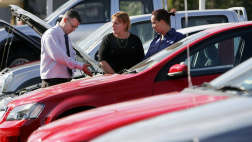The first will be the Volkswagen Up followed by a Skoda version and then one from Spanish arm, Seat. But while each shares the platform and drivetrain, the body style, cabin features and even the target audience will be subtly different, says Skoda board member for sales, Jurgen Stackmann.
"We call it our New Small Car - it hasn't a name yet - which will sit under the wing of the Fabia,” he says. "It won't be a Volkswagen. This is a Skoda so the emphasis is on practicality, strength, reliability and function.”
The NSC - which will share a Volkswagen 1.2-litre engine that is expected to be a three cylinder - won't, however, be sold outside Europe. "It is designed for dense cities and has been designed to be compact on the outside and spacious on the inside.
"This is a clear sign that we are expanding our product portfolio. But we are a relatively small company so we have to take deliberate steps to retain our philosophy. We are the entry portal to the Volkswagen Group and a high-quality option to Asian products.”
The NSC, expected to be shown at the Frankfurt motor show in September, is the first of up to four new models planned over the next three years. Mr Stackmann says the replacement for the Octavia is due in 2013 and shares some design themes with the Vision D concept car shown at this year's Geneva motor show.
"That car isn't as relevant as some people believe,” he says. "But, wait two years - until 2013 - and you'll see some elements of it in a new product,” he says in reference to the next Octavia, now coded the A7. The next Octavia is predicted to move up slightly in size and likely to create a gap in the product range for a car about the same size as the Mazda3.
"It's clearly a growing segment in other (non-mainstream) markets such as China, the Middle East and so on,” he says. "It would work everywhere except Western Europe,” he says, believing the trend is to smaller cars and that the current market is highly competitive.
However, he won't rule it out and that means it has promise for Australia. The other vehicle could be a larger SUV built on the Superb's 4WD platform.
Mr Stackmann says the SUV market was still strong but hinted that rather than a conventional wagon design, Skoda could offer something that was quite different. "It could have all the space and high driving position of an SUV but wouldn't look like any other SUV.”
Asked if Skoda would consider a commercial vehicle such as one based on the Volkswagen Amarok, he says it wasn't within the company's mandate to make such vehicles. "It makes no sense. It would be a huge step outside of what we are and where we plan to go. There are just too many more attractive options.”
Skoda is planning to produce 1.5 million vehicles by 2018 - up from 850,000 expected for this year and the 500,000 annual production of only two years ago. "It's a rich figure,” says Mr Stackmann of the proposed production target. "If things come together as planned, it's achievable. Kia did it - I can't see why we can't.”














.jpg)



.jpg)
.jpg)




